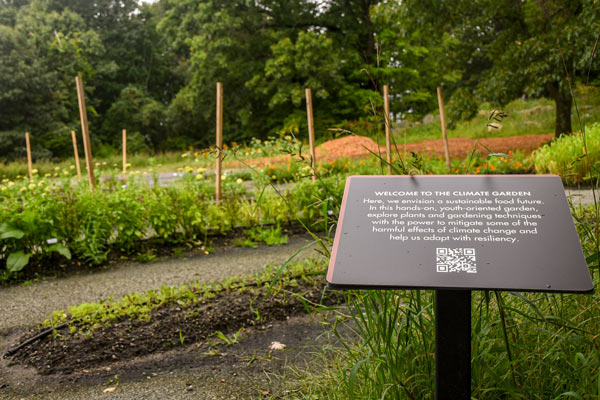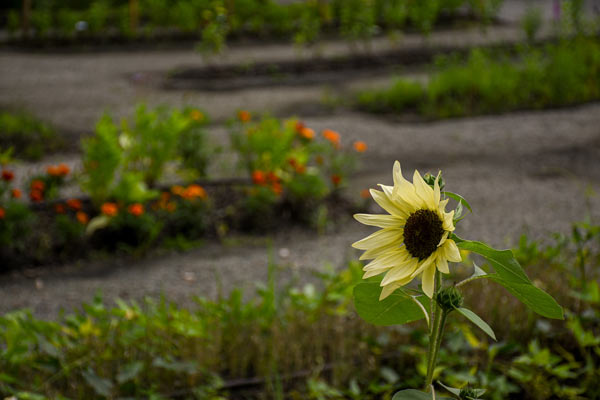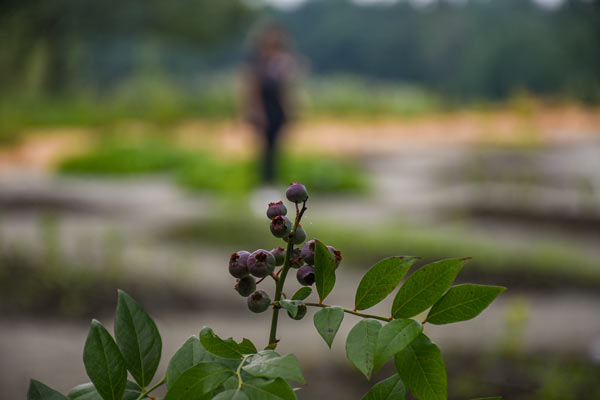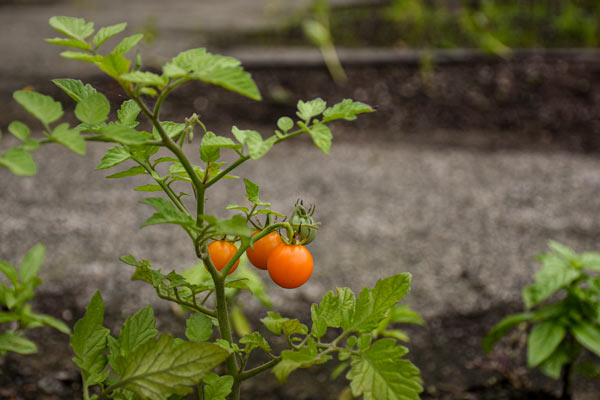By Abrianna Culligan, Horticulturist, New England Botanic Garden
May 2024
 Talking about climate change can be complicated. Key to understanding the dynamics at play is to consider how the global carbon cycle has been disrupted. The burning of fossil fuels has emitted enormous amounts of carbon in the form of CO2 into the atmosphere. This has led to rising temperatures and a variety of other outcomes including more severe weather events that are becoming less and less predictable. To address our changing climate, we must reduce, eliminate, and store, or sequester, this atmospheric carbon in, for example, soil. This brings us to regenerative agriculture, which is a farming philosophy that prioritizes soil health. How we grow our food — from large-scale farms to small-scale home gardens — can play a big role in carbon sequestration.
Talking about climate change can be complicated. Key to understanding the dynamics at play is to consider how the global carbon cycle has been disrupted. The burning of fossil fuels has emitted enormous amounts of carbon in the form of CO2 into the atmosphere. This has led to rising temperatures and a variety of other outcomes including more severe weather events that are becoming less and less predictable. To address our changing climate, we must reduce, eliminate, and store, or sequester, this atmospheric carbon in, for example, soil. This brings us to regenerative agriculture, which is a farming philosophy that prioritizes soil health. How we grow our food — from large-scale farms to small-scale home gardens — can play a big role in carbon sequestration.
In 2023, the Climate Garden opened at New England Botanic Garden with the goal of sequestering as much carbon in the soil as possible while working harmoniously with nature. To do this, we incorporated native and perennial plants into the design, implemented practices that improve soil health like companion planting, and planted for pollinators and other beneficial insects. We hope that home gardeners of all ages can take these ideas and apply them to their own gardens. This way, we can make the world a better place.
Deep Roots for Carbon Sequestration
The Climate Garden is different than many other food gardens because it utilizes native plants and perennials. Generally, the perennials are native, but we’ve incorporated a few non-natives like lovage (Levisticum officinale) and lavender (Lavandula angustifolia) as well. These two groups of plants can be particularly low-maintenance and well-adapted to their environments. This is due in large part to their roots, which form deep and dense systems — these are their superpowers.
perennials. Generally, the perennials are native, but we’ve incorporated a few non-natives like lovage (Levisticum officinale) and lavender (Lavandula angustifolia) as well. These two groups of plants can be particularly low-maintenance and well-adapted to their environments. This is due in large part to their roots, which form deep and dense systems — these are their superpowers.
The root systems of natives and perennials help them thrive. Deep and dense root systems are great at harvesting water and nutrients deep in the soil. They help to stabilize the soil, prevent erosion from wind or water, and prevent nutrient leaching. Their roots also keep the topsoil active, teeming with plant and microbial life. In fact, plant roots are the main energy source for soil microbes, which we need to cycle carbon and nitrogen in the soil and our atmosphere. This contributes to the carbon storage potential of these plants. Because they devote so much energy to their roots, they hold carbon that would otherwise exist as atmospheric CO2 in the soil as living and dead plant material.
Companion Planting for Healthy Soil
 Companion planting is the practice of growing two or more plants together to increase their yields and/or vigor. One plant typically benefits more than the other. This ancient practice keeps the topsoil covered and the soil active with life. It feeds the soil, and healthy soil feeds our plants.
Companion planting is the practice of growing two or more plants together to increase their yields and/or vigor. One plant typically benefits more than the other. This ancient practice keeps the topsoil covered and the soil active with life. It feeds the soil, and healthy soil feeds our plants.
Companion plants serve multiple functions in the garden. One of them is fixing nitrogen, a process in which bacteria convert atmospheric nitrogen into a plant-available form. Legumes, like peas and beans, house these bacteria in their roots. Two additional functions of companion plants are providing structural support and shade. With the Three Sisters, an indigenous planting technique, corn (Zea mays) provides structural support to beans (Phaseolus vulgaris) that fix nitrogen while climbing up the corn and reinforcing the corn with their tendrils. Squash (Cucurbita pepo) shades the ground, which is good for water retention and weed suppression. We have done something similar in the Climate Garden, but with broomcorn (Sorghum bicolor), instead of corn. Broomcorn is a grain native to Africa with superb drought tolerance. By planting in these ways, each plant provides a harvestable crop while supporting the plants and environment around it.
 Planting for Pollinators and Other Beneficial Insects
Planting for Pollinators and Other Beneficial Insects
In the Climate Garden, we’re not just thinking about plants, but about the role of insects in our ecosystems, too. Due to habitat fragmentation, destruction, and climate change, insect populations are threatened. Most insects, however, are beneficial and only a small fraction of all insects are harmful to people or plants. Beneficial insects pollinate our food crops, increasing yields and supporting the reproductive cycles of plants. Their social behaviors as predators and parasitoids help us manage the populations of crop pests. In general, by supporting insect populations, we are supporting a more biodiverse and well-functioning ecosystem that will be more resilient in the face of climate change. For these reasons, it is important to keep insects in mind when planting a garden.
In the Climate Garden, we aim to provide beneficial insects with food, nesting habitat, and a place to overwinter. We also try to support insects by planting a diversity of plant species with varying bloom times within the growing season. Cover crops like buckwheat (Fagopyrum esculentum) attract insects to the garden, feeding them with nectar and pollen. The native wildflowers and bunchgrasses in the Climate Garden’s insectary strip serve a similar function. For example, the crowns and understories of little bluestem (Schizachyrium scoparium) are used by predatory ground beetles as overwintering shelter. This is our way of supporting insect populations and ecosystem health.
Over the next few months, you’ll see a lot of activity in the Climate Garden. Not only will plants be growing, but programs that bring kids and families into the space to learn more about the techniques we demonstrate will also be taking place. You can learn more about these opportunities in the Garden’s calendar of events.
but programs that bring kids and families into the space to learn more about the techniques we demonstrate will also be taking place. You can learn more about these opportunities in the Garden’s calendar of events.
With a climate that is rapidly changing, we are always looking for solutions. One of these solutions is to sequester carbon in our soil. Anyone can do this simply by planting their own garden and following some of the regenerative principles explained above. By being more intentional when we plant, we can better support the climate, ourselves, and other life.
About the Author
Abrianna Culligan is a Horticulturist at the New England Botanic Garden at Tower Hill located in Boylston, MA. She has been with the organization since 2022 and is responsible for the design and maintenance of two of the Garden’s newest spaces, the Ramble, a garden for children and families that includes interactive play features and hundreds of perennials, shrubs, trees, and a pond of seasonal aquatic plants, and the Climate Garden, a hands-on youth-oriented garden focused on sustainable agriculture. Bri earned her Bachelor of Arts in Environmental Science from Hampshire College with concentrations in forest ecology and soil science. Her professional interests include ecological horticulture and climate change mitigation.
